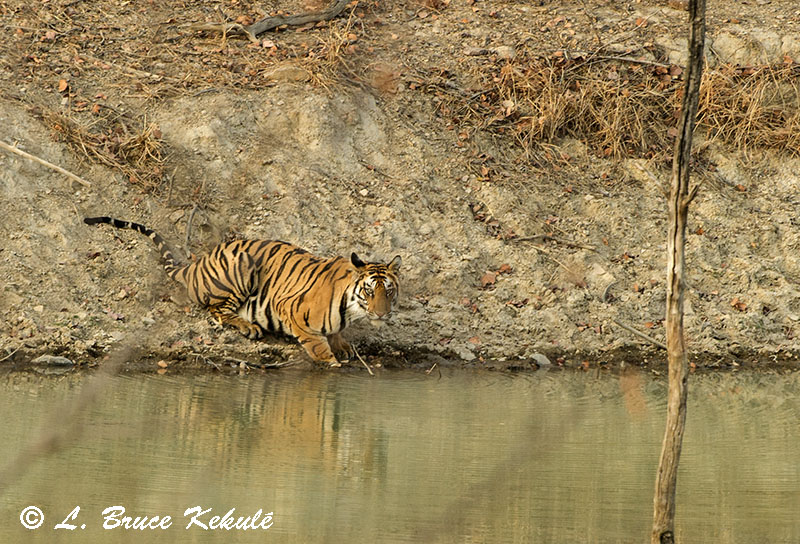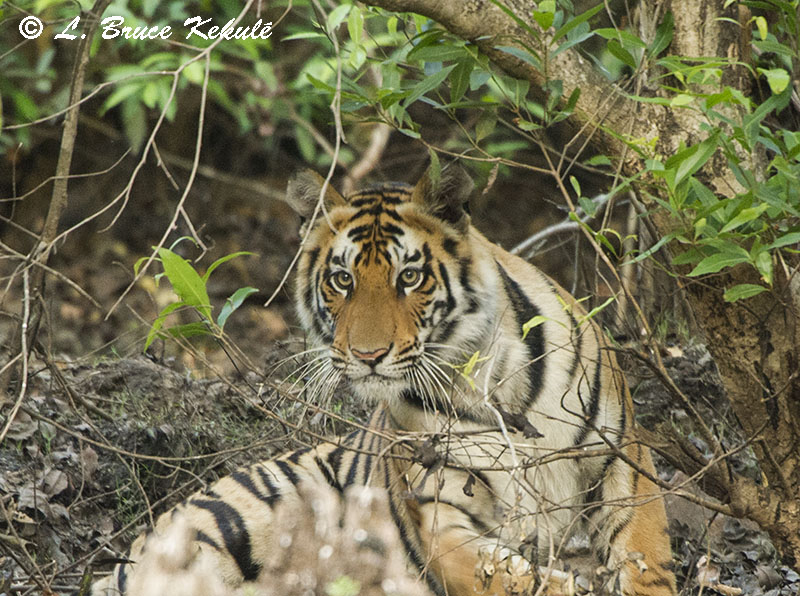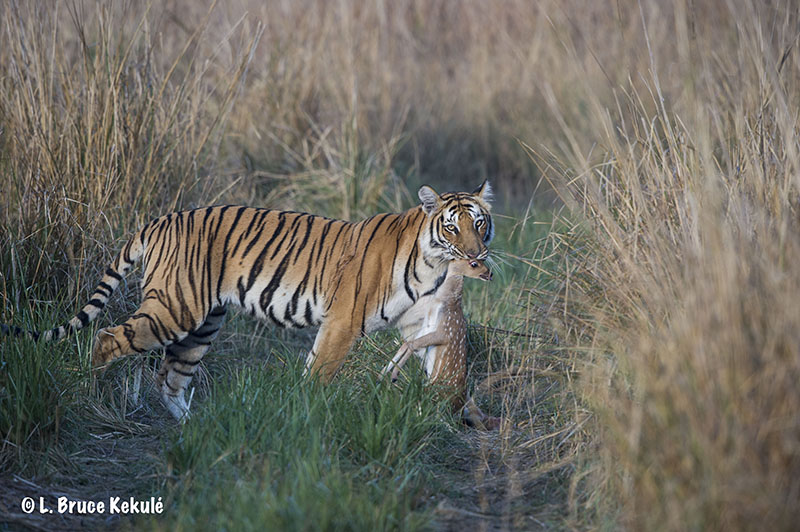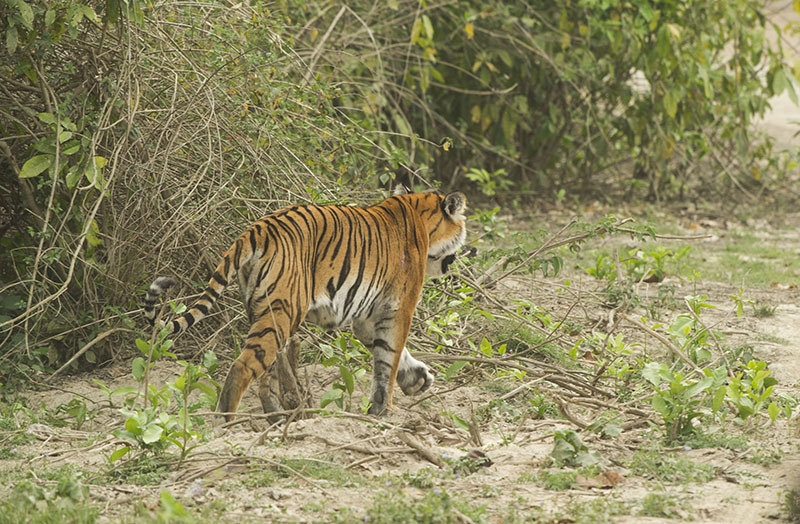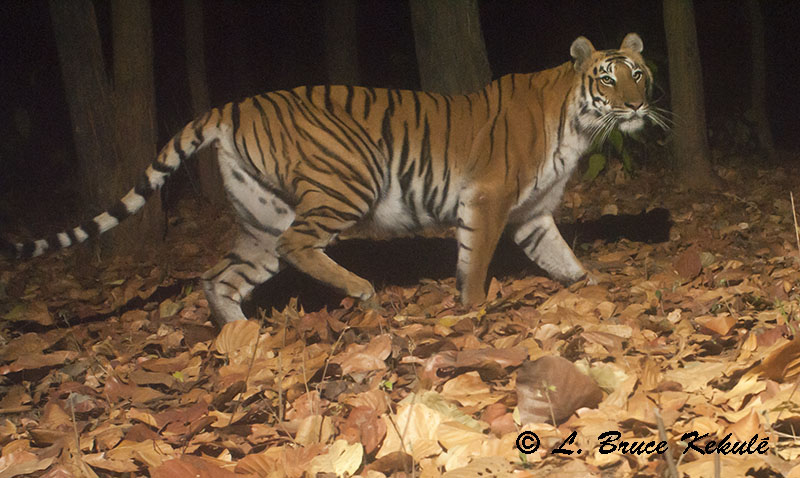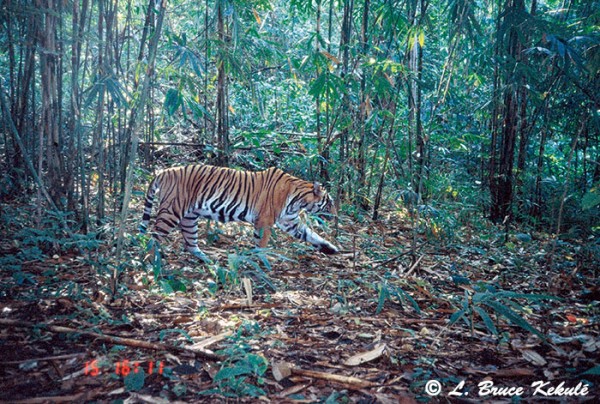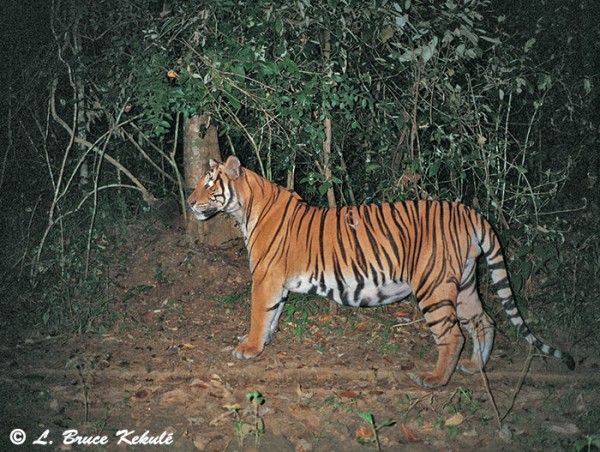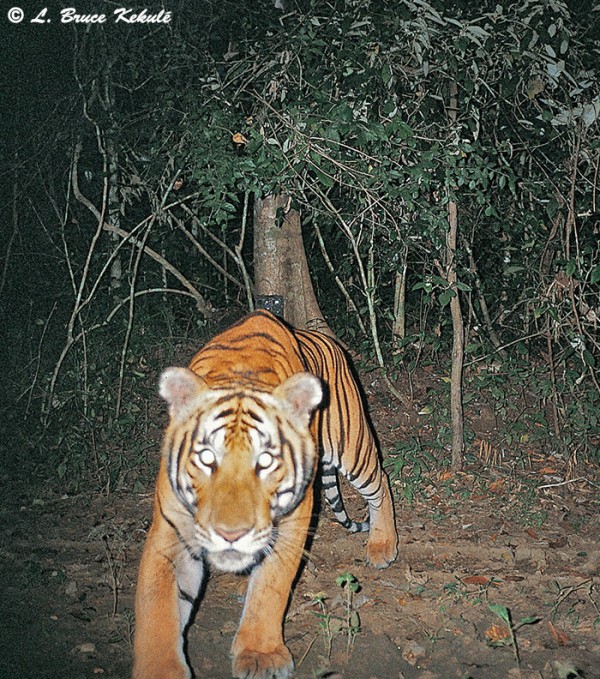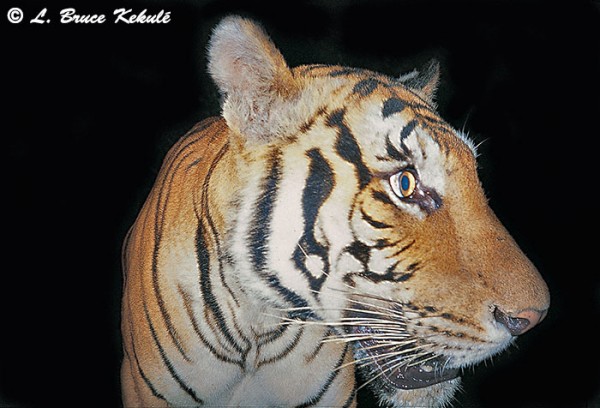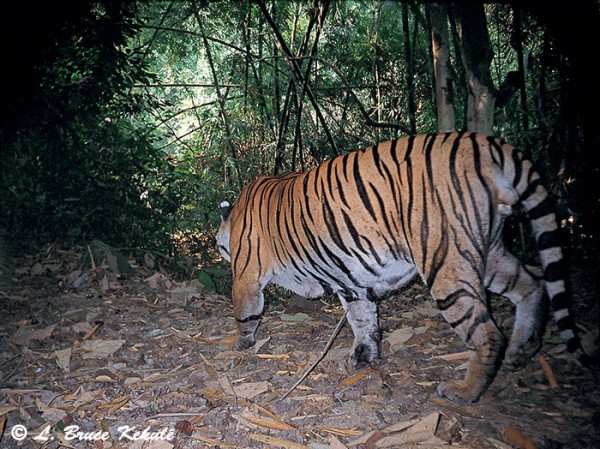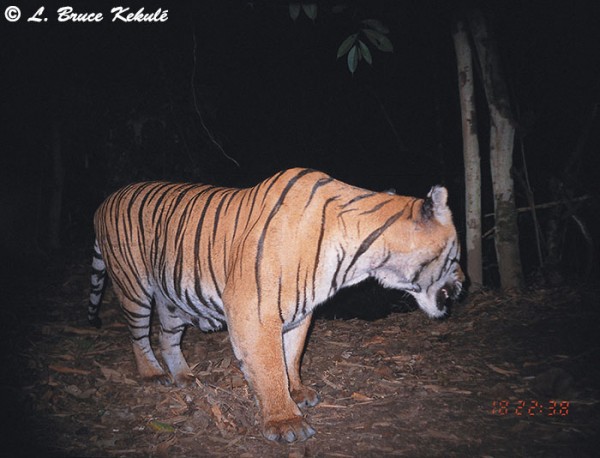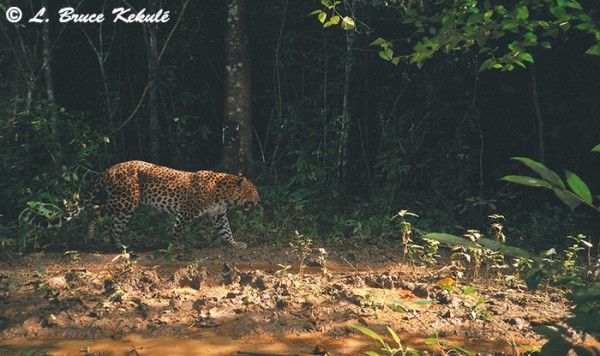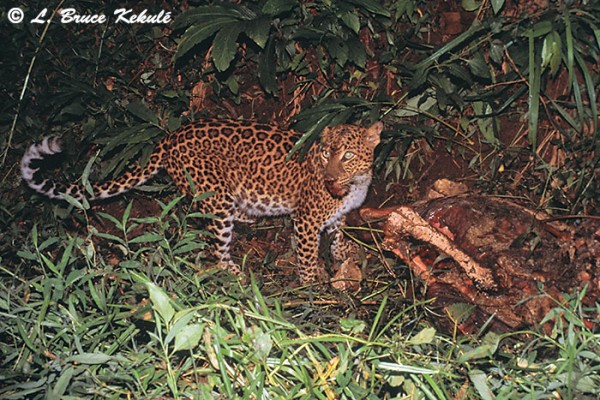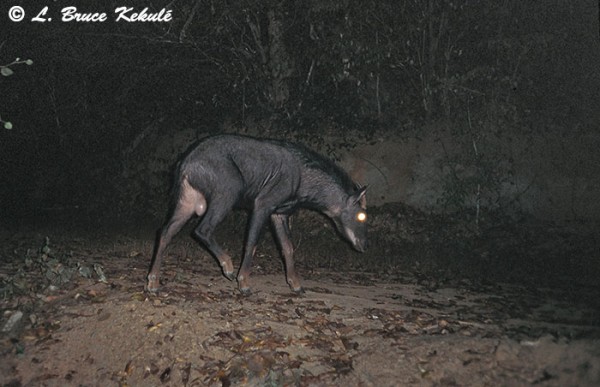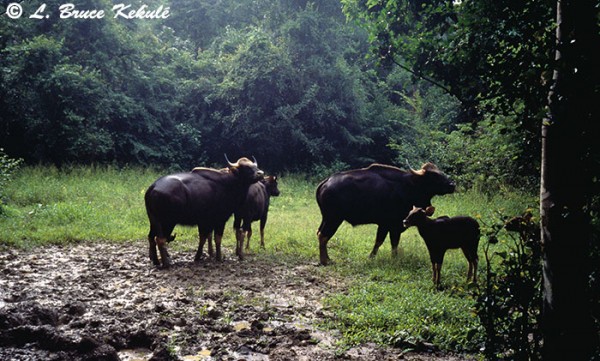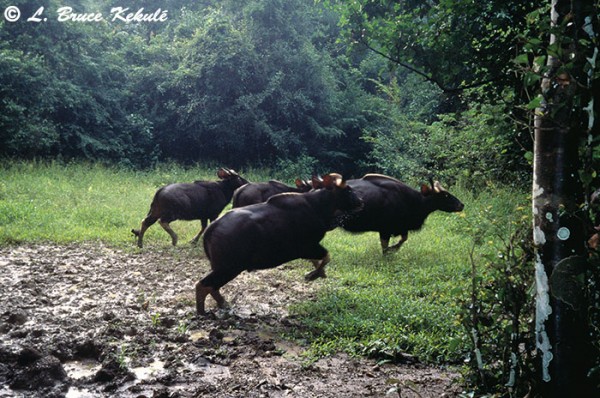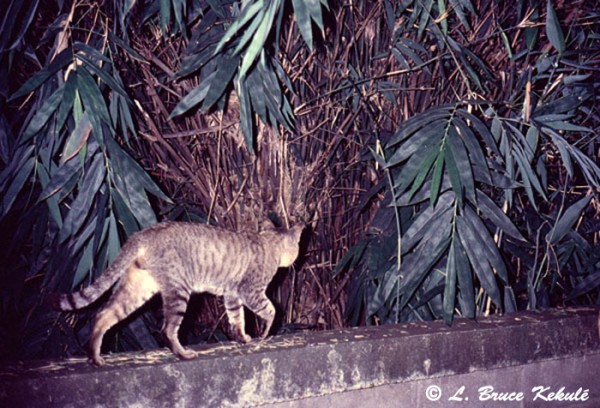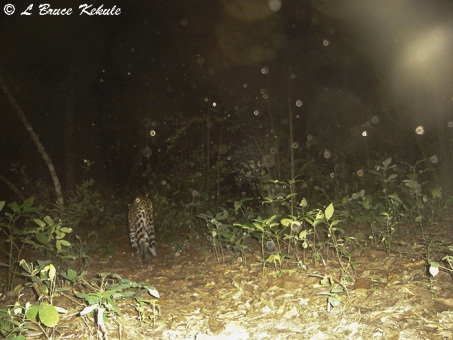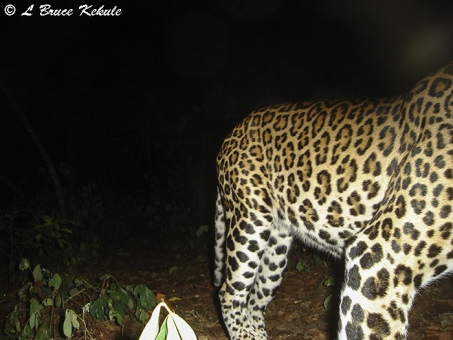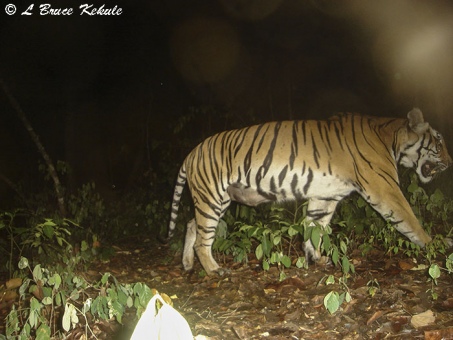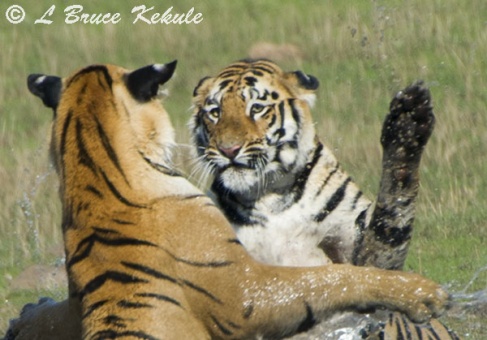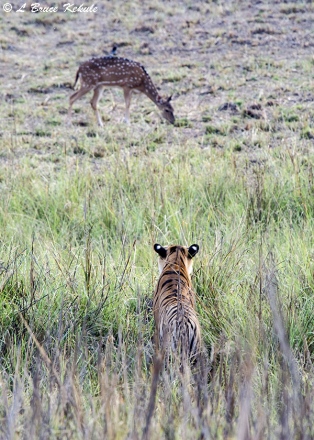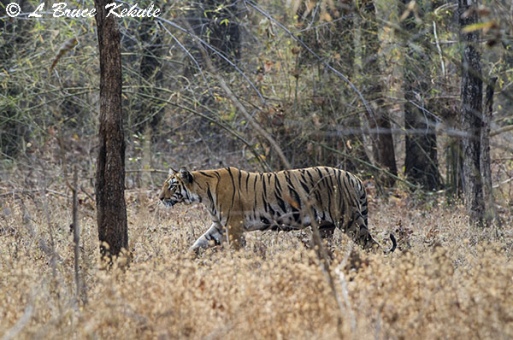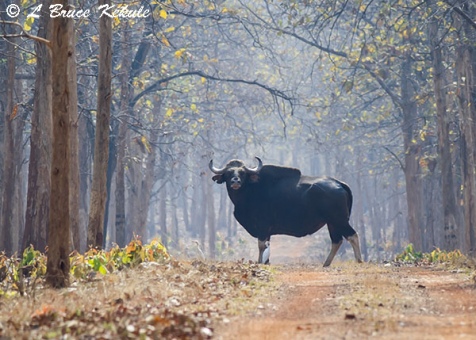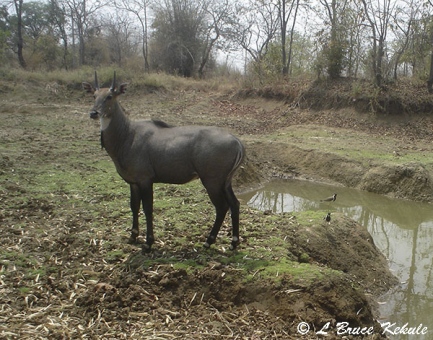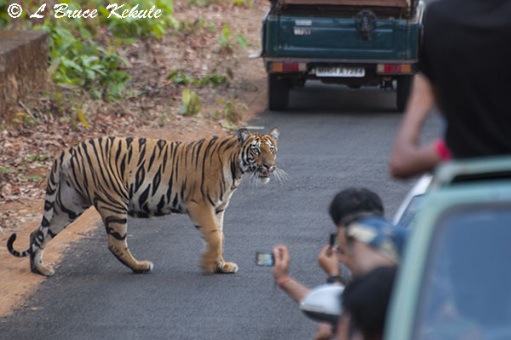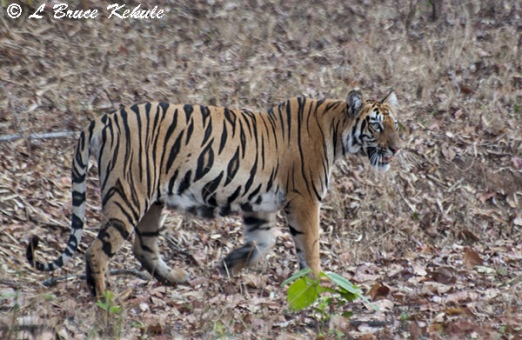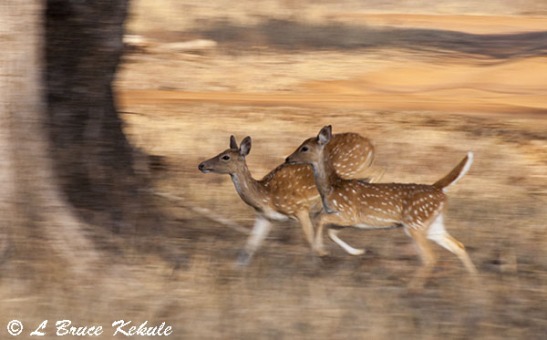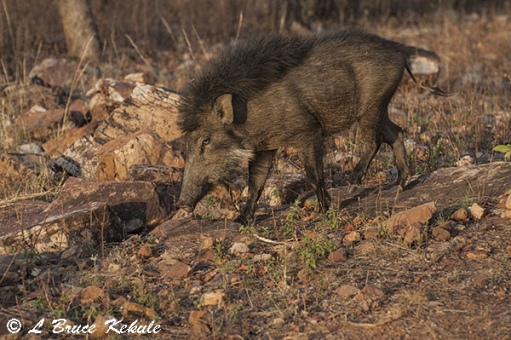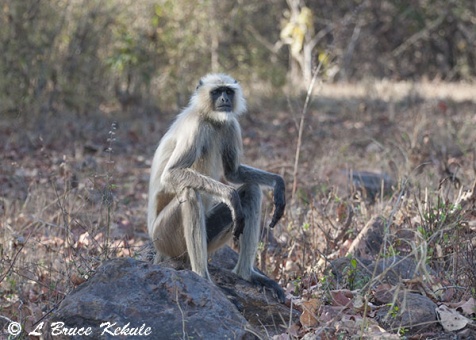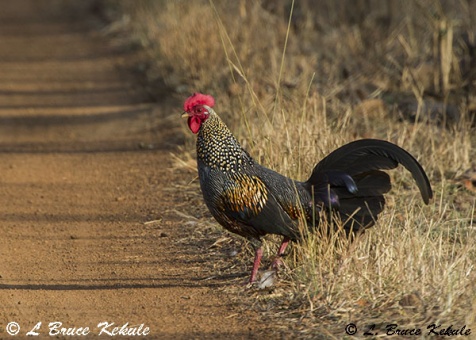Posts Tagged ‘tigers’
Bandhavgarh National Park: A historical tiger reserve
Bandhavgarh National Park is situated in central India in the State of Madhya Pradesh, and has delighted tiger enthusiasts for many years now. Tigers like ‘Charger’, ‘Vijaya’, ‘Spotty’, ‘Dotty’ and ‘Solo’ to name a few have made a name for themselves as real world stars of ‘Mother Nature’ showing off a beauty and charisma found only in a few other places in India.
One of ‘Spotty’s cubs lounging at a waterhole in the interior…!
I have made four trips to Bandhavgarh since November 2014, and have been able to get some very nice tiger photographs including the famous sisters named ‘Dotty and Spotty’. The park is made-up of three zones (1, 2 & 3) and tigers are found in all three. However, one cannot be absolutely sure to get the striped cat and at times, it can be frustrating to say the least, especially when the Forest Department is burning leaves along the side of the road in March. The best time to come is during the hot season (April-May) when water resources are low, and prey and predator are not very far away from the waterholes. My first trip here came-up dry with just a few pug-marks here and there.
‘Spotty’ (in the foreground) leading her two cubs close by the road…!
Being very spiritual, I have come to believe in two mystical beings that are found here. There is a shrine by the side of the main road and another one inside the park in ‘Zone One’ where ‘Siddh Baba’ lives. The other spiritual being is ‘Siddi Mama’ who lives in all ‘Banyon’ trees found throughout India. One day in 2015 as I was motoring around in ‘Zone Two’ after three consecutive days of no tiger sightings in ‘Zone One’, I bumped into a remarkable Indian lady, her husband and their daughter in another jeep. As usual, the drivers stopped to exchange ‘tiger information’.
One of ‘Spotty’s cubs scent marking by the road…!
The lady asked me where I was from; I said Thailand and then mentioned that I had not seen any tigers yet…she then said, “maybe your luck will change as you (me) are under a banyon tree” and “you need to go into town and buy a coconut, some incense and then make an offering to the small roadside shrine where ‘Siddh Baba’ lives out on the main highway.
My first tiger in Bandhavgarh: A sub-adult male in ‘Zone Two’…!
We parted company and said our goodbyes. A few minutes later and around the corner like magic, a juvenile male tiger stepped out onto the road and I got some amazing shots of the young striped cat. Boy, my luck changed immediately. My driver and I then went into town for lunch, and we got a coconut and some incense. We were going to pray on the way back but time was limited so we decided to stop by the shrine after the evening safari.
‘Dotty’ on the road in the interior of ‘Zone Two’: My second tiger that lucky day…!
We got to the gate and waited for the 3pm opening. After a half hour, we split up from the other vehicles and proceeded into the park by ourselves. Around a corner, and we mystically bumped into ‘Dotty’, a mature female tiger standing on the road. I was elated to say the least but it did not take long for a bunch of other jeeps to show up and then the free-for-all mayhem began. But I was lucky to get her with no commotion and undisturbed. She then slipped into the forest after all the noisy drivers started shouting and crashing into each other tying to get a glimpse of her. We departed and I felt great. We stopped by ‘Siddh Baba’s shrine on the way back in darkness and payed our respects for my good fortune. I now stop by every time I visit Bandhavgarh. There is also another ‘Siddh Baba’ shrine in ‘Zone One’ several kilometers in by the side of the road.
My first tiger in ‘Zone Three’ in 2017: A sub-adult male in late afternoon…!
I have just returned from Bandhavgarh and got ‘Spotty’ and her two cubs in ‘Zone One’ in the afternoon of the third day shown above. News quickly spread that the three were next to the road. When we got there, some 20 jeeps were packed into a small section following every move they made. The going’s-on was almost deafening all trying to get the best position.
My second tiger in ‘Zone Two’ in 2017: Her name is ‘Solo’ and she was out hunting in the morning sun…!
Funny enough, ‘Spotty’ and her cubs do not pay to much attention to the din. I did however get a few shots but it was difficult to say the least. So that makes 49 tigers I have photographed in India. I did however, get a fresh pile of tiger scat on the rode in the interior of ‘Zone Two’.
‘Spotty’ in ‘Zone One’ in 2017: She is a very popular tiger and very photogenic…!
I also got a leopard on a rocky outcrop shown below just past the ‘Siddh Baba’ shrine not far from the gate at ‘Zone One’. That was just after my guide told me that the ‘ghost of the forest’ are occasionally seen in this patch of forest. Now that’s what I call ‘extreme luck’…!
A leopard spotted in a rocky outcrop not far from the ‘Siddh Baba’ shrine in ‘Zone One’…!
So with that in mind, I recommend giving Bandhavgarh a try but be prepared for some unpleasant mix-ups when a tiger is spotted. The Forest Department here really needs to fix this problem for the future and maybe take-up the new regulations and rules that are now in place in Kanha Tiger Reserve. See my story on my recent trip to Kanha…! (:http://brucekekule.com/photography_abroad/kanha-national-park-the-best-run-protected-area-in-india/)
Long live the tigers in Bandhavgarh…!!
FOUR TIGERS IN THREE DAYS
Jim Corbett’s spirit is alive and well
Paarwali tigress in the grass on my last morning in Corbett…!
I have been coming to India since 2013 when I made my first visit to Tadoba Anhari Wildlife Sanctuary and National Park situated in Maharashtra State…it is one of the best tiger reserves in the sub-continent and I managed to photograph seven tigers over nine days on that trip. This was the first of many trips to India after tigers.
A male tiger crossing the road near the grasslands close to Dhikala Camp…!
I have just returned from Corbett National Park in Uttarakhand State in the North, this being my 4th trip to one of India’s greatest protected areas. It is a stunning tiger reserve with many, many tigers. However, these predators like in most places, can be elusive and I was only able to catch one every trip for the first three years but I did get some stellar shots on those previous visits shown here.
Male tiger crossing the Ramnagar River on my 2nd morning in Corbett…!
This trip, I managed to get four tigers in three days in the Dhikala Zone. The first one was a male that crossed the road in front of our jeep near closing time in the grasslands. The second male tiger in mid-morning was caught crossing the Ramnagar River but at quite a distance. And on the third day in the morning, the very famous tigress, Paarwali and her male cub were seen in the rocky section of the river. They both made there way closer to us and then jumped across the road a short twenty meters away. It does not get any better than that…!
Paarwali crossing in front on my jeep on day three…!
So my count now is 44 tigers in India. I have set some camera traps in the Terai Landscape on private land near the Ramnagar River and look forward to seeing the big striped cat on my traps. Leopards, goral, serow, sambar, chital, wild pigs and elephant also frequent the area. Only time will tell but that is another story.
Paarwali’s male cub jumping in front of our jeep on day three…!
A young tigress chasing after chital deer in the grasslands near to Dhikala Camp on my first trip to Corbett-2015…!
Paarwali tigress with a chital fawn kill on my 2nd trip to Corbett-2016…!
A male tiger crossing the road in the Sal forest near Dhikala Camp on my 3rd trip to Corbett-2017…!
Forty Tigers…!
India’s amazing big cats
About 20 years ago when I began wildlife photography, I dreamed of going to India to photograph tigers. The rich biodiversity found on the sub-continent is without equal and boasts the largest population of the big striped cat in the world.
My first tiger in India; one of four cubs around ‘Telia Lake’ in Tadoba-Anhari-2013…!
Tiger cubs sparring in Telia Lake, Tadoba-Anhari..a once in a lifetime shot…!
The first photographic book in my library on wildlife is titled ‘Wild India’ by the renowned British photographer, Gerald Cubitt and published by New Holland in London. He traveled all over India capturing most of the wild animals on film including the majestic tiger. The urge to go after this big cat burned in me for many years.
‘Telia lake’ cub up-close on my third morning in Tadoba…!
In late-2009, I photographed an Indochinese male tiger (though the lens) in Thailand from a blind which is a very difficult feat to accomplish. These carnivores are so smart and extremely wary, and tough to see in the wild let alone photograph. I also camera-trapped many tigers in several protected areas situated around the Kingdom.
Tiger cub near the road in Tadoba…!
Tadoba-Andhari Tiger Reserve – Maharashtra State – Count: 11 tigers…!
Tiger cub hunting chital at Telia Lake…she was hesitant and missed the deer…!
But the desire to visit India burned in me until I finally made my first trip in April-2013 to Tadoba-Andhari Tiger Reserve and National Park. I was with my good buddy Luke Stokes who is an up and coming photographer in his own right, and he lives in Thailand like me. We made the flight from Bangkok to Hyderabad, and then the 9-hour taxi ride to the park. I was finally in the ‘Land of the Tiger’…!
Old ‘Wagdoh’ (Scarface) at Telia Lake…he still is the dominant male in this area…!
At the time, Tadoba was one of the top reserves for tiger sightings in India with four tiger cub sisters growing up around Telia Lake. On our second morning, I managed to get a once in a lifetime shot of two sisters sparring in the water. I was certainly off to a good start.
‘Wagdoh’ on the third morning by the road…!
‘Wagdoh’ at the lake the next day,,,!
The next morning, we bumped into the dominant male and father of the four sisters; old Wagdoh (Scarface) out on the road, and a day later, photographed him at the lake. We also got the other two sisters around the lake during the week. Then, we got a breeding pair over in Tadoba National Park as they went about their natural business.
A breeding pair over in Tadoba National Park…!
On our next to the last day in the park, one of the sisters (the jumping tiger facing me) made an appearance near the road to say goodbye, and I got some wonderful close-up shots of her.
Tiger cub by the side of the road saying goodbye…she is the same tiger facing me in the sparring shot…!
Then in early-2015, I made a second trip to Tadoba and managed to get three tigers including Maya T12, Choti Tara T17 and finally, ‘Gabbar’ or ‘Leopard Face’ T42 that had been injured in a fight with another male tiger.
‘Maya’ or T12, is a mature tigress in Tadoba, 2015…!
‘Choti Tara’ or T17, another mature tigress on the road in Tadoba National Park…!
‘Gabbar’ or ‘Leopard Face’ or T42 with a radio collar cooling off in a pond in Tadoba National Park…he was badly injured fighting with another male…!
Ranthambore Tiger Reserve – Rajasthan State – Count: 6 tigers…!
In November-2014, I visited Ranthambore that is India’s most famous tiger reserve. On the third morning of my 7-day safari, I managed to photograph the very infamous dominant male tiger named ‘Ustad’ or T-24, and then later that day got another male named Zalim or T-25, and one of his cubs (he was looking after two cubs at that time).
The infamous ‘Ustad’….I caught him in Zone 1 on my third day…!
Then the next day, I got Ustad’s son ‘Sultan’ or T-72 two days in a row. Finally, I snapped ‘Krishna’ or T-19, an equally legendary tigress. Shortly after that, ‘Ustad’ was thrown in a zoo (jail) on trumped-up charges of killing a forest guard. It became a world-class scandal. Poor ‘Ustad’ was out and never to be photographed in the wild again..!
‘Zalim’ out hunting…he had left his two cabs in the bush…!
‘Zalim’s’ cub in thick bush. This was the only shot I got of this young tiger…!
‘Sultan’ looking bored in Zone 6…one of my favorite tiger shots….! A huge crowd of hundreds of Indian tourist had should up behind me…!
‘Sultan’, son of ‘Ustad’ the next morning, also in Zone 6…!
‘Sultan’ saying goodbye in Zone 6…!
‘Krishna’, a tigress near the Ranthambore Lake…!
Bandhavgarh Tiger Reserve – Madhya Pradesh State – Count: 7 tigers…!
When I made my first trip to Bandhavgarh in November-2014, I was not lucky and did not see any tigers over a four-day visit except for some pug-marks. But in early-2015, I made a second trip to the park and on the finale day of my 4-day safari, got a sub-adult male in the morning and then in the afternoon, photographed ‘Dotty’, a very famous tigress in Zone 2.
A sub-adult male tiger in Zone 2 in 2015…a lucky encounter after 4 days of no sightings….!
A tigress named ‘Dotty’ in the afternoon on day four…another lucky shot…!
In early March of this year (2017), I made my third visit and caught a sub-adult male in Zone 3 on the very first afternoon. The next morning, I bumped into ‘Spotty’ (sister of ‘Dotty’) and two of her cubs (8-9 months old) in Zone 1. On my next to the last safari, I bumped into ‘Solo’ in Zone 2, a mature female at distance for a nice tiger habitat shot as she sat in the morning sun looking for prey.
A sub-adult male on my first day in late afternoon on March 2017 in Zone 3….!
On my second day, we bumped into ‘Spotty’ (sister of ‘Dotty’) and her two cubs in Zone 2…!
‘Spotty’s’ cub on the road in Zone 2…!
‘Spotty’s’ other cub following her sibling and mother….!
A tigress named ‘Solo’ out in the morning sun waiting on prey….!
Kanha Tiger Reserve – Madhya Pradesh State – Count: 1 tiger…!
In early-2015, I visited Kanha Tiger Reserve. Sightings were down at that time but I finally was able to catch the ‘Budbudi’ female tiger one morning as she walked, roared and scent marked looking for a mate. She came real close to our jeep and crossed in front of us, and then posed on the other side.
‘Budbudi’ female tiger marking territory in Kanha…!
‘Budbudi’ female on the other side of my jeep…!
Pench Tiger Reserve – Madhya Pradesh State – Count: 8 tigers…!
In early-2015, I also traveled to Pench and on the very first morning, got the ‘Patdev’ female tigress and photographed her again in the afternoon. The next morning, I got a sub-adult male. On the third morning, I managed to get some great close-up shots of the very famous ‘Collarwali’, a female tigress with seven litters and 26 cubs to her name.
‘Padtev’ tigress in Zone 1 on the first morning in the bush…!
‘Patdev’ tigress in Zone 1 in the afternoon (second sighting that day)…!
Sub-adult male on my second morning…!
‘Collerwali’ on the road in 2015 early the third morning….!
In early-2016, I made a second trip to Pench and photographed ‘Collarwali’ and her two cubs. Then, I got the famous ’Raiyakassa’ male tiger the next afternoon.
‘Collarwali’ still sporting a collar in the early morning on the first day in 2016…!
‘Collarwali’ yawning out in the morning sun..
‘Collarwali’s’ cub and mother resting in the morning…!
‘Raiyakassa’ male tiger and ‘Collarwali’s’ mate in Pench near the lake on March. 2016
I just finished my third trip to Pench but after four days, I left empty-handed. The Forest Department had just burnt fallen leaves along all roads to create fire-breaks and I believe this pushed all the tigers into the interior. There were no sightings in the park at all since the burning.
Panna Tiger Reserve – Madhya Pradesh State – Count: 2 tigers…!
In early-2016, I also traveled to Panna Tiger Reserve. As most people know, Panna lost all their tigers due to poaching sometime in 2009. The Forest Department decided on a reintroduction program and moved several tigers including a female named T-1 from Bandhavgarh into Panna.
A female cub from the ‘T-1 female’ introduced from Bandhavgarh Tiger Reserve…!
On my very first afternoon, I was lucky and photographed T-1’s female cub at a waterhole. On my third and final day, I got T-1’s other female cub at another waterhole.
Another one of ‘T-1’s’ cubs. This was on my way out of the park…she said goodbye…!
Corbett Tiger Reserve – Utterakhand State – Count: 3 tigers…!
Of course, no trip to India would not be complete without visiting Corbett Tiger Reserve in Northern East India. This park is named after the very famous Jim Corbett (naturalist, photographer, author and hunter of many man-eating tigers and leopards in India).
In early-2015, I managed to catch a young female tigress chasing chital deer in the Dhikala grasslands not far from the camp. Throughout that day, we saw her several times.
A young tigress in the Dhikala grasslands chasing chital deer…2015…!
‘Parrwali’ tigress near the Ramgangar River with a chital fawn in her jaws…2016…!
Parrwali on ‘Sambar Road’ not far from Dhikala camp…!
In early-2016, I photographed Corbett’s most famous female tiger at the moment named ‘Parrwali’ with a chital fawn kill in her jaws across the Ramgangar River. This is my best shot of a tiger in India so far; predation is tough to get and I was lucky. I then caught Parrwali and an un-named sub-adult male tiger on ‘Sambar Road’ the next two days.
A mature male tiger crossing the road not far from Dhikala camp…a habitat shot…2017…!
I have just returned from a trip to Corbett in Dhikala and Birjani areas. On the second morning in Dhikala, a male tiger crossed the main road through the ‘Sal forest’ in mid-morning not far from camp and I was able to get some nice shots in the morning sun. In Birjani, I did see the famous ‘Sarmilly’ female tiger in the afternoon on the second day but she stayed hidden for the most part and I did not get a photo.
Kaziranga National Park – Assam State – Count: 0 tigers…!
In Early-2015, I traveled to Kaziranga, one of India’s greatest wildlife reserves with some 2,400 Asian one-horned rhinos, 1,300 wild water buffalos and 1,000 Asian elephants. There are suppose to be about 200 tigers in the park. However, I did not get a tiger but only a set of pug-marks one morning.
Satpura Tiger Reserve – Madhya Pradesh State – Count: 0 tigers…!
In early-2015, I traveled to Satpura but did not see a tiger. They are very difficult to see here.
Vanghat (Private) Eco-lodge – Utterakhand State – Count: 1 tiger…!
I have always wanted to use camera traps in India but the Forest Department does not allow outsiders to do this in any of the tiger reserves, and for the most part is set aside for their own research teams. After some consultations with the owner of an eco-lodge near Corbett, it was decided to set a DSLR camera trap near the Ramgangar River up a mountain ridge line. I managed to get a great shot of a young female tiger on the second night.
Young tigress camera trapped in the Corbett landscape up a ridge line near the Ramgangar River….2016…!
You can say I’m hooked on photographing tigers in India. I’ve just finished my sixth trip and got 6 tigers this time. I look forward to future visits to add more tiger shots to my files.
Note: This number is the actual tigers photographed with some duplication. Nikon D3s, Nikon D4s, D3oos bodies and Nikon 200-400 and Nikon 70-200 Telephoto lenses were used plus a Nikon D3000 for the camera trap shot…!!
Eight tigers in two-weeks…!
A month long safari to the Indian sub-continent
Collarwali, the ‘Queen of Pench’ passing in front of my jeep; she has had 22 cubs and 6 litters and is one of my favorite tigers in India…!
India is a spectacular wildlife paradise showcasing the magnificent Bengal tiger. There is about two thousand thriving on the sub-continent and it’s the largest population remaining on the planet. These big cats still thrive very well in many protected areas and even outside some parks and sanctuaries, and at times are quite easy to see. However, they can also be very elusive and it really depends on one’s luck.
I arrived in New Delhi on March 20th at noon from Bangkok, Thailand, which takes about three and half hours flying time. Air India is a great airline and allows 40 kilograms of check-in baggage on business class which I needed as I had two DSLR camera traps, two sensors and four flashes, plus other assorted photographic equipment like my tripod, boots and clothes, etc. My two bags were very close to that limit and I hate paying overweight…!
I stayed in Delhi for one night and then caught the train the next afternoon going north to Ramganga city arriving in the evening and staying at the Tiger Camp Lodge on the way to Corbett Tiger Reserve and National Park. I slept well after the four-hour train-ride that is hectic going through Old Delhi train station fighting thousands of people to get on board. It is a madhouse…!
VANGHAT WILDLIFE RESERVE
The Vanghat female tiger camera trapped with a Nikon D3000 trail cam…!
The next morning, my first stop was Vanghat Wildlife Reserve and Lodge (private land) situated on the Ramganga River which is reported to have tiger, leopard, crocodile and other creatures common to the Corbett Landscape in the lower-Himalayan Mountains. The owner, Mr. Sumanthn Ghosh is an avid nature lover and was eager to see what was roaming his forest and hills. Little did he or I know that a female tiger was around and tripped my Nikon D3000 camera trap on the night of March 28th up on a ridgeline. She turned out to be prime female living in her patch.
CORBETT TIGER RESERVE
‘Parwali’ female tiger in Corbet Tiger Reserve with a spotted deer (chital) fawn…!
The next morning, I went into Corbett National Park to visit the grasslands at Dhikala Lodge run by the government where many tigers roam looking for prey. On the second morning, we bumped into a female that was hunting across the Ramganga River. Timing was perfect and she stepped on to the road with a spotted deer fawn in her mouth. It certainly was a once-in-a lifetime shot for me and I was pleased to say the least. Over the next few days, I saw her a few more times here and there. At that moment, Parwali (her name) is the most photographed tiger in Corbett and I feel lucky to have captured her with prey; behavior is tough with tigers..!
PANNA TIGER RESERVE
Panna’s larger female cub of T-1 on my first afternoon safari…!
From Corbett, it was back to Delhi on the train followed by anther train ride going further south but this time it was an overnighter. At my age, sleeping on a train is almost impossible and it was a long night. The next morning, we arrived at Khajuraho station and a driver was there to pick me up and drive to the Ken River Lodge owned by Mr. Shyamendra Singh on the Ken River not far from the main gate into Panna Tiger Reserve.
Panna’s smaller cub of T-1 on my last afternoon at a secluded waterhole by the road…!
That afternoon, Mr. Shukra, a very experienced guide and I entered the park at 3pm and in the late afternoon, saw a female cub from T-1 at a waterhole taking a drink. (Panna lost all their tigers in 2008 and she was the first reintroduced tiger). On my last safari, I bumped into T-1’s other smaller cub. Now that was some seriously good luck.
PENCH TIGER RESERVE
Collerwali yawning after a late morning slumber not far from the Pench River…!
Then after a long 8-hour taxi ride, I ended up in Pench Tiger Reserve southwest of Panna, and met up with my good friend Omeer (Omi) Choudhary, a guide, driver and naturalist for the Tuli Tiger Corridor Lodge. Over the next couple of days, he put me in front of Collerwali, the ‘Queen of Pench’ and the most famous tigress with 22-recorded cubs and 6 litters. I also saw two of her latest cubs, a male and female. And then Omi put me in the right place near closing time to catch Mr Big known as ‘Raiyakassa’ as he walked up from a mud bath. It was hot and he was cooling off.
Collarwali’s male cub watching the jeeps with the queen resting behind him…!
Collarwali’s female cub resting on a rock during a late morning safari…!
Raiyakassa, the male tiger and Collarwali’s mate just up from a mud-hole…!
That was it — eight tigers in two weeks. I guess I was lucky but I did pray to ‘Jim Corbett’s spirit plus the spirit of the Banyon Tree; Sitti Mama. She knew what I wanted and provided me with some amazing tiger shots… Overall, a successful trip and one that will be etched in memory for as long as I live…!!
Wild Thailand Part One and Two
For the first time, a snarling tiger shows what their reaction is to a video cam with red LEDs when actuated at night. This male tiger is a resident at this location in the ‘Western Forest Complex’…a black leopard also passed the cam several times but did not actually look at the LEDs and so no reaction was recorded.
At the second location, the tigers did not seem too bothered by the red blob…! I now have a few cams including my Nikon D700 set-up here and hopefully will catch a tiger with my DSLR trail cam…!! Please enjoy these videos and even though they are a bit fuzzy, still show Thailand’s amazing natural heritage at its best.
Forgotten memory stick..!
Leopard passing a S600 after a rain.
Awhile back, one of the members on Camtrapper.com forum (zaj56) posted on June 22, 2013 ‘some bear pics’ and had forgotten to put a memory card in his cam but the internal memory (10 shots) was able to get some very nice bear shots.
A leopard up-close to the S600.
A night predator passing-by.
Going through my S600s recently fixing on/off switches (just posted on the forum), I found some shots on the internal memory from November 2012 on one cam and decided to have a closer look.
A tiger up-close to the S600.
Imagine my surprise when I saw 10 shots including a tiger and leopard close to the cam. This means I had forgotten to put a memory card in the cam and just lucked out getting the two big cats.
A tiger passing by the S600.
The moral of this blurb: Try not to forget your memory card before deploying the cam…!
Tadoba Andhari Tiger Reserve – Nine tigers in seven days
A dream come true: Central India’s top protected area for tiger sightings
Tiger sisters sparring in Tadoba Andhari
Same tigers facing off in the lake.
When the tiger evolved in southern China some two million years ago, the species radiated out, north to Siberia and west to the area around the Caspian Sea. The Himalayan mountain range prevented them from moving south into Nepal and India.
Tiger male by the road early one morning.
From China, it moved through Indochina on down the Malay Peninsula via the now submerged Sunda landbridge to Sumatra, Java and Bali in Indonesia. From there the striped cat moved west through Burma to the Indian sub-continent. The Bengal tiger is the second largest after the Siberian species.
A breeding pair in the northern section.
A century ago, there were more than 100,000 tigers throughout their range and India had about 40,000 at that time. Now, it is estimated that maybe 3,200 of these magnificent predators are left in the world with some 2,000 thriving in India and Nepal.
Tiger cub stalking a spotted deer by the lake.
The Indochinese species is just hanging on with about 250 in Thailand and another 250 in Malaysia. Sumatra has about 400 tigers. The Chinese, Caspian, Balinese and Javan tigers are all now extinct, a sad fact!
Tiger cub in the afternoon.
A internet search revealed that there is one protected area that stands above all the others for tiger sightings in India. Tadoba Andhari Tiger Reserve for some time now has been one of India’s most famous for the ease of seeing and photographing the big cat up-close and personal at times. Tadoba was declared a tiger reserve in 1933 and a National Park in 1955.
Bull gaur on the road in the buffer zone.
A buffer zone was recently added and the total area is now 1,700 sq. kilometers. Many other animals are found here including leopard, sloth bear, wild dog, gaur, sambar, chital (spotted deer), nilgai (blue bull), four-horned antelope, muntjac, mugger crocodile plus loads of smaller mammals and birds including the spectacular Indian blue peafowl and the beautiful grey jungle fowl.
Chital stag on the run being chased by wild dogs.
Overlooked by tourist until recently, this forest is situated in central India in the Maharashtra state about 700 kilometers north of Hyderabad. It is split into two parts, north and south. Only 20 percent is now open to the public, and the other 80 percent off-limits to everyone except forest officials after a Supreme Court decision last year in September. The court wanted to close all of the tiger reserves but an outcry from the people was heard and many parks now have only limited access.
Sloth bear near the lake.
Arrangements to travel like visas, air tickets and lodge bookings were arranged and I took off on Thai Airways to Hyderabad on April 4th, arriving at 1:00pm and then undertook a nine-hour taxi ride to the sanctuary. It was scary, to say the least after we got lost in rural India for a short while. The taxi driver finally got back on track and we arrived at the sanctuary at noon.
Wild dogs resting in an evergreen stream bed.
Lunch was served at the Tiger Trails Jungle Lodge situated five-minutes from the front gate of the reserve that would be my home for the next nine days. The food, lodging and service is excellent, and well worth the expense to get there. The closest city is Nagpur only two hours by road and is serviced by daily flights.
Nilgai (Blue Bull) antelope camera trapped near the Tiger Trail Jungle Lodge.
In the afternoon at 3pm, I made my first safari in a ‘Maruti’ jeep (Suzuki) with a naturalist from the lodge, a tour guide and a driver. We got a glimpse of a tiger as the sun was going down. The next day at daybreak, we went south to a lake in the interior. It was reported that four female tiger cubs, and a mother and father were sighted almost everyday in the area.
Tiger cub on the road among the tourists.
We arrived, as did many other jeeps, and we sat in the cool morning waiting for the family to arrive. At 9:30am, the first cub came out of the deep forest across from us and walked past submerging itself in the water to cool off. Then another cub arrived from the other side and they both joined up, and began sparring and facing off. I was ready with my Nikon D3s and a 200-400mm VR lens on a monopod catching the pair in mid-air as seen in the lead photo.
Tiger cub checking out a Tadoba forest official.
The next morning after only five minutes from the gate, we bumped into a male tiger 50 meters from the road out in the open grassland sleeping. Shortly thereafter, he woke up and posed for me. Then we moved to the lake and a cub walked past our jeep about three meters away. We saw tiger everyday except for Tuesday when the park is closed. I however, got a huge gaur bull in the buffer zone next to Tadoba shown here.
Tiger cub emerging after a late afternoon nap.
In the northern section, there is a breeding pair of tigers also shown in the story. They should produce a nice litter that will be an attraction for this place sometime late this year. The four cubs at the lake should disperse very soon. There are many other mature tigers and cubs throughout the sanctuary and at last count, there are about 75 individuals in the park and buffer zone.
Tadoba’s rock pantheons along the road in the tiger reserve.
Tadoba has a rich history that goes back to the 17th century. Once upon a time, dynasties of Gond Kings ruled this part of the Deccan plateau. When the kings traveled through the area, the message of his arrival would be transmitted by an engineering feat. There were rock pantheons erected every hundred yards, which had perfectly aligned tops. Over these were drawn inter-connected ropes which rung a bell at the end. The soldier just tugged on the rope and the bell would ring 50 kilometers away, signaling the approach of his majesty. Many of these rock pillars are still standing seen in the story.
Chital female posing near the road.
Like most things, my safari finally came to a close. I left the lodge at mid-day and dreaded the long taxi ride back to Hyderabad but we eventually arrived at the airport at 9pm. The driver pulled through and got me there in one piece. Then it was a bit of a hassle getting through customs and immigration as security is tight but once through, I had a chance to relax and get something to eat. I boarded the plane for the short three and half hour flight and before I knew it, was home back in Bangkok.
Chital on the run being chased by wild dogs.
India has many problems with poachers and encroachment. Two national parks, Sariska and Panna, had all their tigers poached in a short period of time. As long as there is a market for wildlife parts, the trade in these will continue to carry-on with impunity. However, the government has already reintroduced tigers to these parks but it could take a long time for them to recover fully.
Young sambar stag with tiger claw marks.
Tiger skin, bones, organs and even whiskers are sold in a million-dollar black market to Chinese, Vietnamese and Tibetan buyers. It is heartbreaking that barbaric wildlife traffickers have the audacity to trade the tiger and other animals in bits and pieces, by the gram and kilo.
A mature sambar stag with some serious battle scars.
If you want to see a tiger in the wild, head to India which offers the best opportunities to view the striped predator. There are many tiger reserves and depending on luck, one may bump into one. But Tadoba is at the top of the list for sightings. I definitely will be heading back to this amazing place and hopefully in the near future, more areas will be opened up.
A wild pib in Tadoba.
Unfortunately, Thailand could never offer this wildlife spectacle as the tiger and other Asian creatures have been persecuted for so long making these animals extremely wary which has made sightings rare. But it is still possible in places like Thap Lan and Pang Sida in the northeast, Kaeng Krachan and Kui Buri in the southwest and over in the western protected areas like Sai Yok and Erawan national parks to bump into one.
A gaur in bamboo not far from the road.
I have been working in Huai Kha Khaeng Wildlife Sanctuary for more than 15 years, Thailand greatest tiger sanctuary, and have only seen and photographed one male tiger. However, there are many tigers in this forest (about 75) as witnessed by loads of camera trap photos that have come forth from researchers and wildlife photographers. Needless to say, we need to look after this and other places that have tigers so that these magnificent creatures may continue to thrive into the foreseeable future!
Additional photos from the safari
Langur monkeys are common by the road
A langur posing close to the jeep.
Indian blue peafowl in the bamboo.
Wild boar on the run.
Indian grey mongoose drinking at a waterhole.
Indian grey jungle fowl by the road.
Grey jungle fowl in early morning.










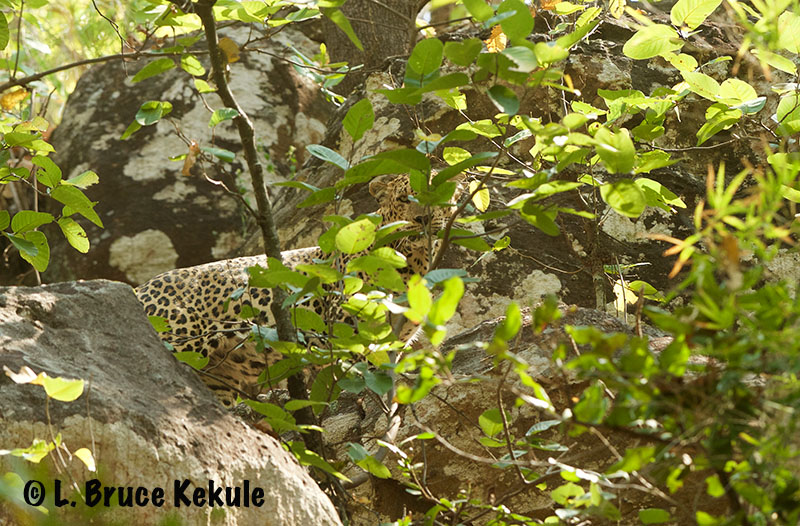







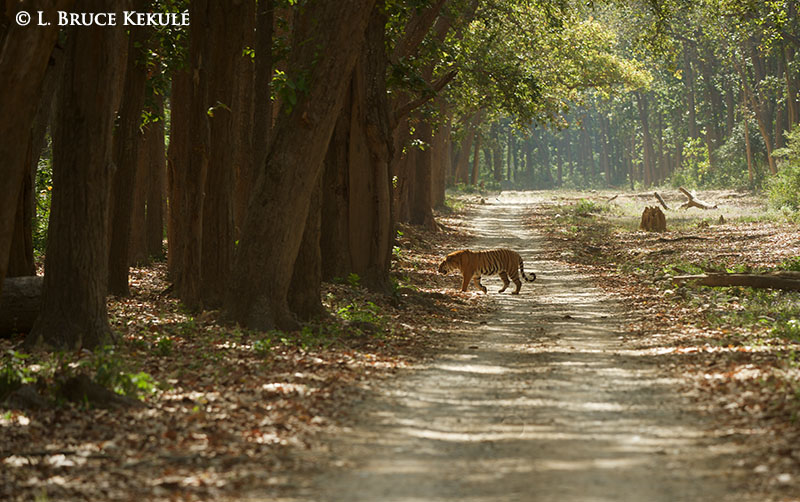
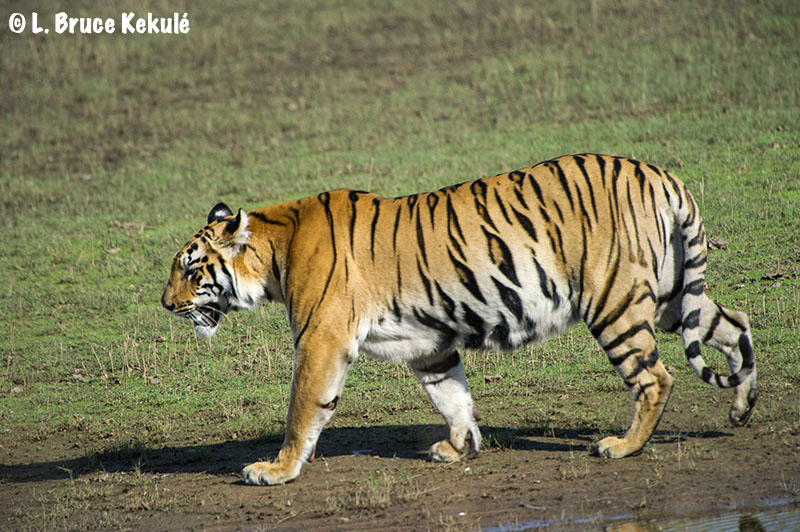




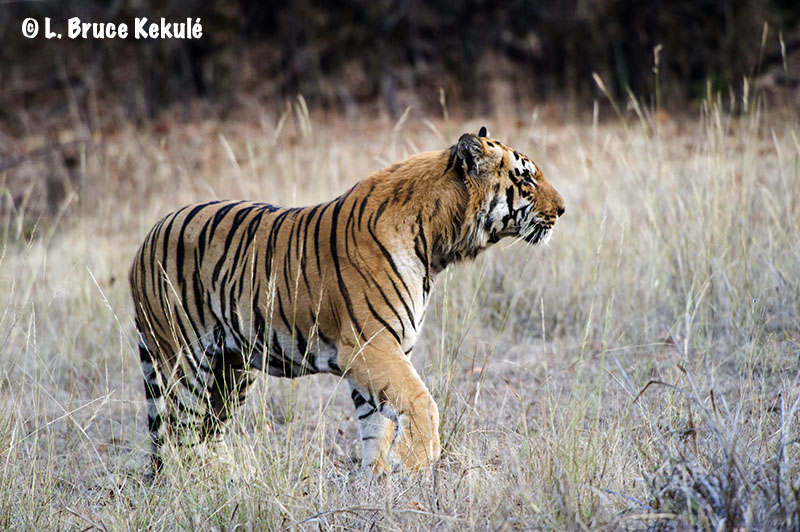




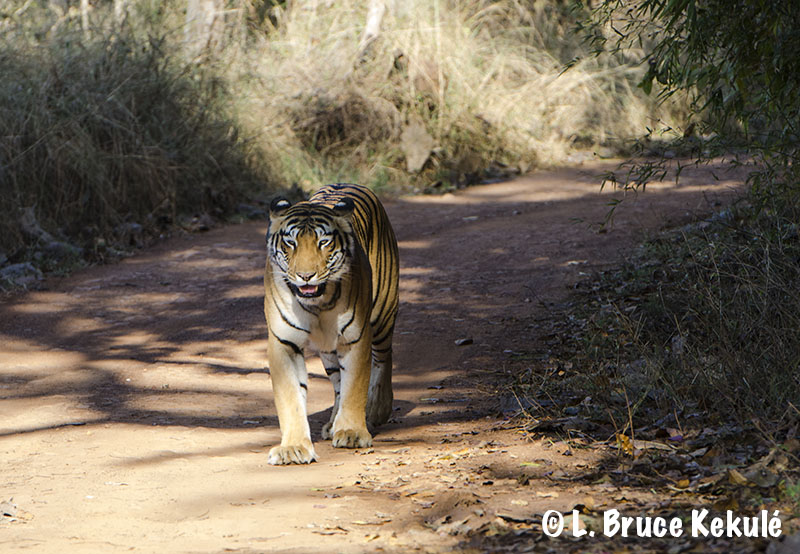


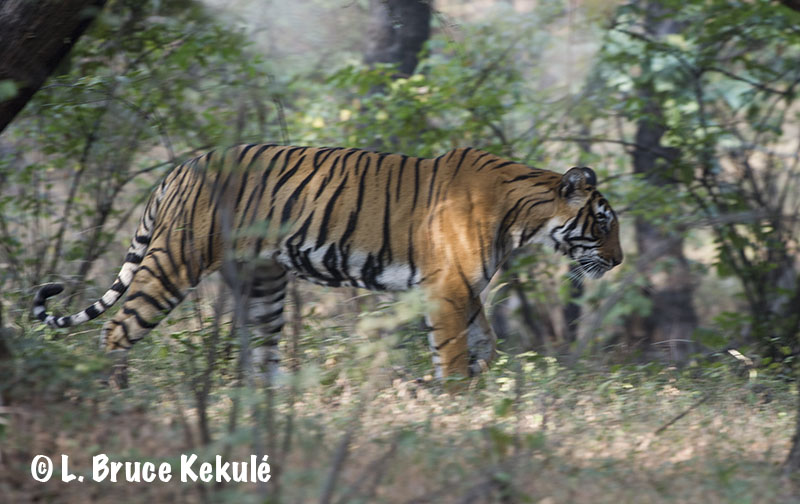

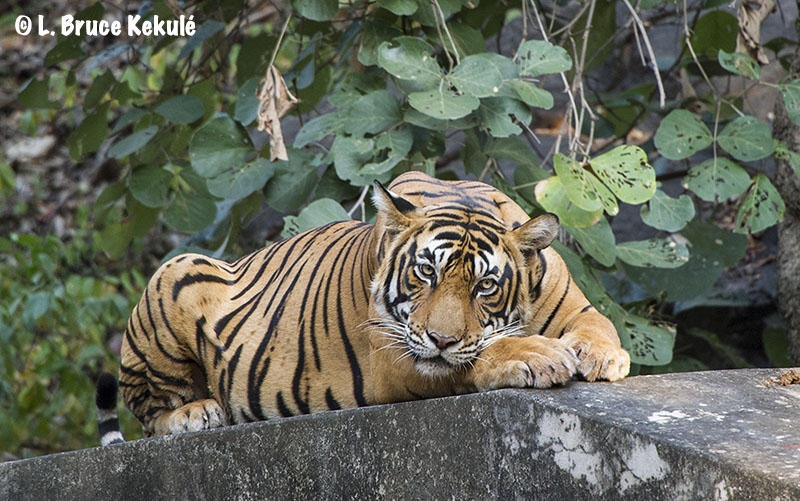

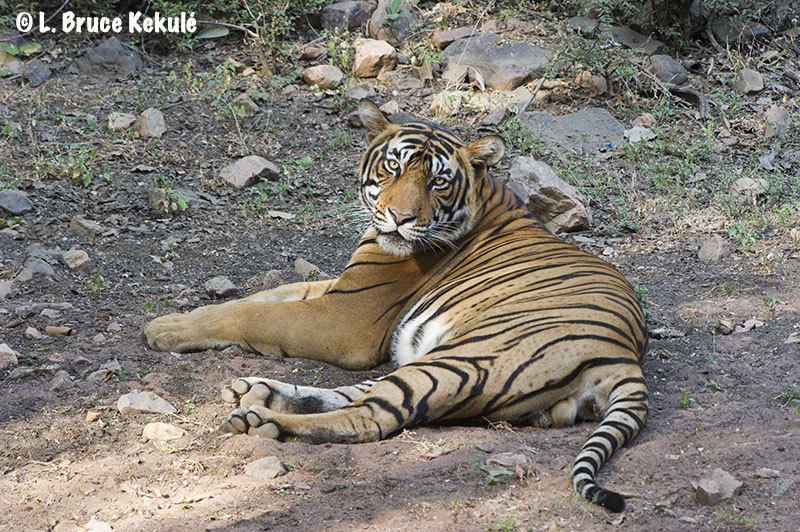






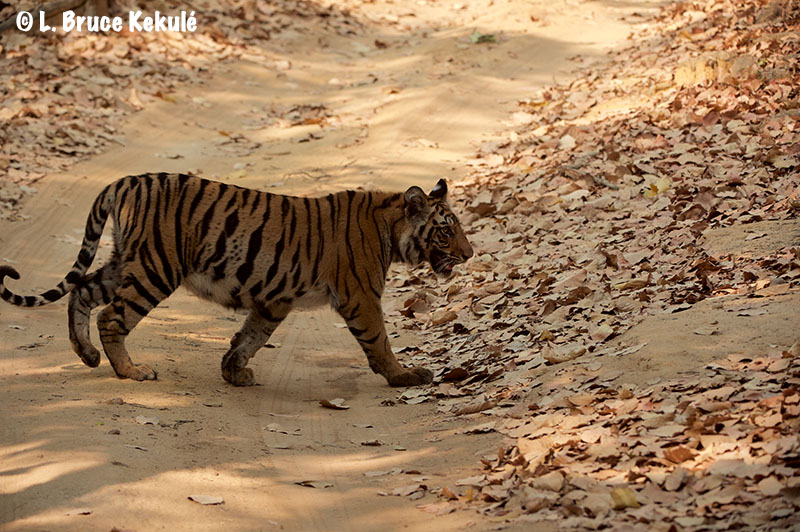


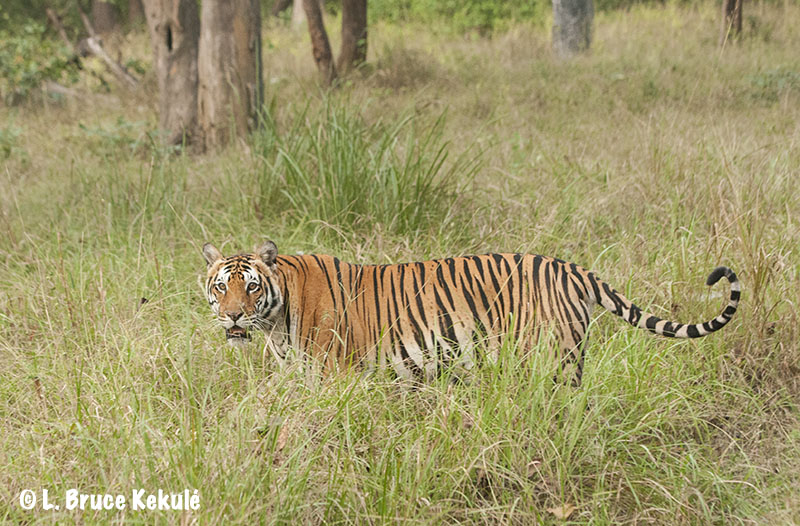
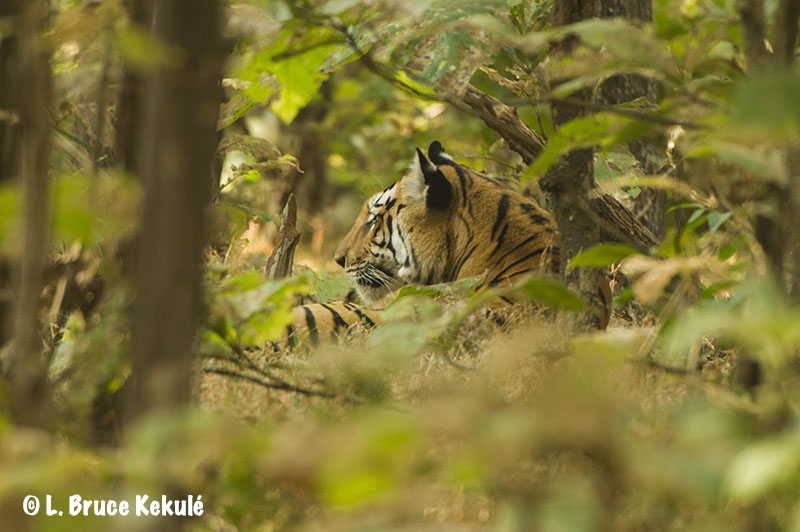

 tev
tev




